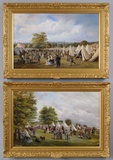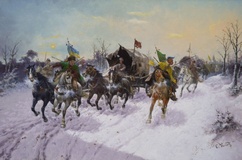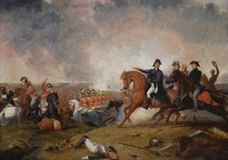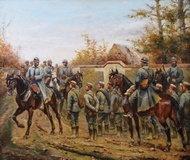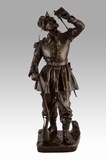Abraham Cooper RA
British, (1787-1868)The charge of the 1st Cavalry Brigade
Oil on panel
Provenance: Mr Henry Brock Hollinshead of Hollinshead Hall, Preston;
Mr James Cross of Coney Garths, Ripon; Rev. James Cross of Sturminster Marshall;
The Parker Gallery, London
A dramatic oil painting by Abraham Cooper featuring the Duke of Wellington at the battle of Waterloo. The Duke can be seen on horseback to the right with other officers as soldiers of the 1st Regiment of Life Guards engage in fighting to the left. The painting was later made into an engraving that appeared in the book ‘The Life, Military and Civil of the Duke of Wellington’ by William Hamilton Maxwell, p360, published by H G Bohn in 1852. According to the handwritten inscription, the painting was owned by Henry Brock Hollinshead of Hollinshead Hall in Preston, Lancashire. Further research has discovered that Brock Hollinshead sold the contents of his house when he moved out of the area in 1845. Details of the sale, including a mention of the painting and its companion appeared in the Blackburn Standard on 2 April, 1845, p1. It was purchased at the sale by James Cross of Coney Garths, Ripon in Yorkshire. It was subsequently inherited by his son Rev. James Cross (1847-1931), who later held office at the parish of Sturminster Marshall, Wimborne, Dorset from 1877-1931. The painting was then owned by the Parker Gallery (possibly during the 1950’s).
Cooper produced a number of works about the Napoleonic Wars which were exhibited at the RA, including ‘Wellington at Waterloo’ (1838), ‘The 19th of June – a Scene in Belgium’ (1845), ‘The Life Guards, in the costume they wore in 1815 ‘ (1846), ‘Two Old Campaigners – Portraits of Marengo and Copenhagen, the favourite chargers of the Emperor Napoleon and the Duke of Wellington’ (1856). A study for a similar work depicting the Battle of Waterloo is held by the Royal Academy of Arts (RA). This scene could also have been a preliminary work for a much larger painting.
Abraham Cooper was born in Holborn, London on 8 September, 1787 to Alexander and Susanna Cooper. His father was an inn keeper and the family lived at Red Lion Street in Holborn. Although little is recorded about his early education, he is known to have started working at Astley’s Amphitheatre at the age of 13 before becoming a groom for the brewer Henry Meux. His close work with horses inspired him to learn how to paint and he began producing paintings of the horses in his care. Encouraged by Meux, he became a pupil of the animal painter Benjamin Marshall (1768-1835) who took him into his studio.
Under Marshall’s tutelage he flourished as an artist and developed a lifelong interest in historical scenes particularly of battles, which earned him the nickname ‘Battle Cooper’. In 1812, he made his debut at Royal Academy in 1812, becoming a prolific exhibitor there. In the same year he also began exhibiting at the British Institute.
He married Maria Goom on the 23 April, 1813. The couple lived in Robert Street, Holborn and went on to have 3 children together. Their son Alfred William Cooper (1829-1916) studied at the RA and became a well-known artist and illustrator. By 1817, he had moved to New Millman Street in Holborn where he remained for over 30 years. In 1817, he was made Associate of the Royal Academy and in 1820 was elected full Academician.
In 1853, a few years after the death of his first wife, he married Francis McArthy D’Ebro a widow and the daughter of an artist. The couple continued living at Cooper’s home in Millman Street until sometime after 1861 when they moved to Woodbine Cottage, Woodland Street, Greenwich.
Cooper died aged 81 at his home in Woodland Street on 24 December, 1868. He was buried at Highgate Cemetery. Examples of his work can be found in many public collections including the Ashmolean Museum, Cromwell Museum, English Heritage, Government Art Collection, Harris Museum, National Trust, The Wilson, V&A and Yale Center for British Art. A number of his papers including sketches, correspondence and photographs of him can be found at the RA.
© Benton Fine Art
| Presentation | The painting is housed in a new, English made gilt frame which is in excellent condition. The reverse bears an inscription in pencil by Rev. James Cross: “Bought by James Cross at (I think) sale of Brock Hollinshead of Hollinshead Hall, Preston, C1847”. There is also the remains of an old handwritten label (see image) and a label for the Parker Gallery. |
| Condition | As with all of our original antique oil paintings, this work is offered in ready to hang gallery condition, having been professionally cleaned, restored and revarnished. |
Dimensions
| Image Size | 11.25 inches x 15.5 inches (28.5cm x 39.5cm) |
| Framed Size | 16.5 inches x 20.75 inches (42cm x 53cm) |
You May Also Like











